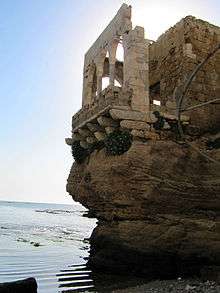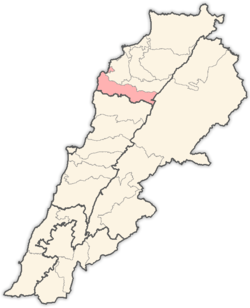Batroun
Batroun (Arabic: البترون al-Batrun; Aramaic: בתרון; Syriac script: ܒܬܪܘܢ Bitron) is a coastal city in northern Lebanon and one of the oldest cities in the world. It is the capital city of Batroun District.
Batroun البترون | |
|---|---|
City | |
 Street in Batroun | |
 Batroun Location within Lebanon | |
| Coordinates: 34°15′0″N 35°39′0″E | |
| Country | |
| Governorate | North Governorate |
| District | Batroun District |
| Government | |
| • Mayor | Marcelino al-Harak |
| Elevation | 34 m (112 ft) |
| Population | |
| • Total | 45,000 |
| Time zone | UTC+2 (EET) |
| • Summer (DST) | UTC+3 (EEST) |
| Dialing code | +961 (6) Landline |
Etymology
The name Batroun derives from the Arabic al-Batroun, itself from the Greek, Botrys (also spelled Bothrys), which was later Latinized to Botrus. Historians believe that the Greek name of the town originates from the Phoenician word, bater, which means to cut and it refers to the maritime wall that the Phoenicians built in the sea to protect them from tidal waves.[1] Other historians believe that the name of the town is derivative of the Phoenician words, beit truna, which translates to house of the chief.
Economy and urban development
Historically, the city of Batroun was settled at the interface between the sea and the national road that connected Beirut to Tripoli.
Lately, the radical shift of the historical functions of the local economic tissue into a leisure service-based economy (nightclubs, bars, restaurants, stores, etc.) has become the unique and only lever of the development of the city.[2] The economic metamorphosis has resulted in the resettlement of housing towards emerging city suburbs (nearby hills: New Batroun, Batroun Hills, Basbina, etc.) consequently to the overvaluation of the real estate market in the city centre. It clearly reveals here the constitution of a business city-centre (dedicated to leisure and business) balanced by the constitution of residential suburbs, where accelerated urban sprawl has led to the destruction of natural lands (pinewood and orange groves) and to the fatal rise in land prices.[3]
Tourism




Batroun is a major tourist destination in North Lebanon. The town boasts historic Roman Catholic and Greek Orthodox churches. The town is also a major beach resort with a vibrant nightlife that includes pubs and nightclubs. Citrus groves surround Batroun, and the town has been famous (from the early twentieth century) for its fresh lemonade sold at the cafés and restaurants on its main street. Biking along the Batroun coastline is also a major activity namely in late summer days. In 2009, the Batroun International Festival was born. It started hosting leading local and international artists. The festival takes place usually in July and/or August of each year in the old harbor area.
Demography
The people of Batroun are mainly Maronite, Melkite, Greek Orthodox Christians and Muslims. Batroun is a Roman Catholic (Latin rite) Titular See[4][5][6]
History
Batroun is likely the "Batruna" mentioned in the Amarna letters dating to the 14th century B.C. Batroun was mentioned by the ancient geographers Strabo, Pliny, Ptolemy, Stephanus Byzantius, and Hierocles. Theophanes called the city "Bostrys."[7]
The Phoenicians founded Batroun on the southern side of the promontory called in Antiquity, Theoprosopon and during the Byzantine Empire, Cape Lithoprosopon. Batroun is said to have been founded by Ithobaal I (Ethbaal), king of Tyre, whose daughter Jezabel (897-866 B.C.) married Ahab.[8]
The city was under Roman rule to Phoenicia Prima province, and later after the region was Christianized became a suffragan of the Patriarchate of Antioch.
In 551, Batroun was destroyed by an earthquake, which also caused mudslides and made the Cape Lithoprosopon crack.[9] Historians believe that Batroun's large natural harbor was formed during the earthquake.[10]
Three Greek Orthodox bishops are known to have come from Batroun: Porphyrius in 451, Elias about 512 and Stephen in 553 (Lequien, II, 827). According to a Greek Notitia episcopatuum, the Greek Orthodox See has existed in Batroun since the tenth century when the city was then called Petrounion. After the Muslim conquests of the region, the name was Arabicized to Batroun.
One of Batroun's medieval archaeological sites is the Crusader citadel of Mousaylaha which is constructed on an isolated massive rock with steep sides protruding in the middle of a plain surrounded by mountains.[11]
Under Ottoman rule, Batroun was the centre of a caza in the mutessariflik of Lebanon and the seat of a Maronite diocese, suffragan to the Maronite patriarchate. Since 1999 it has been the seat of the Maronite eparchy.[12]
Politics
Elections, municipal and parliamentary, in Batroun have seen increasing interest, namely in the context of local and national struggle for power. Namely, the ongoing Lebanese Minister and leader of Lebanon's Free Patriotic Movement Gebran Bassil is a Batroun local. He seeks national recognition and to promote his party's policies from his hometown. The current serving Mayor of Batroun is Marcelino El Harek.
Landmarks
- The Ancient Sea Wall
- El-Bahsa beach
- Makaad El Mir
- El-Mseilha Fort
- St. Stephan's Cathedral
- Historic Souk
References
- Archived July 20, 2006, at the Wayback Machine
- Sfeir, Nagi (August 2018). "Local economic development via urbanism lever: the case of Lebanon" (PDF). SAUES Journal. 1 (2): 62–78. doi:10.22034/saues.2018.02.01.
- Sfeir, Nagi (2013). "Realurbanism: or the Urban Realpolitik. Towards a " Spatialisation " of the Realist Paradigm from International Relations Theories »" (PDF). Journal of Settlements and Spatial Planning. 4 (1): 1–10.
- "Catholic Encyclopedia: Bothrys". Newadvent.org. Retrieved 2012-11-12.
- "Botrys". Catholic-Hierarchy.org. David M. Cheney. Retrieved 23 January 2015.
- David M. Cheney (2012-10-24). "Its Bishops and Dioceses, Current and Past". Catholic-Hierarchy. Retrieved 2012-11-12.
- Malalas, Chronogr., XVIII, in P.G., XCVII, 543, cited in Bothrys - Catholic Encyclopedia article
- (Menander, in Josephus, Ant, VIII, xiii, 2), cited in Bothrys - Catholic Encyclopedia article
- Malalas, Chronogr., XVIII, in P.G., XCVII, 704, cited in Bothrys - Catholic Encyclopedia article
- "The historical earthquakes of Syria: an analysis of large and moderate earthquakes from 1365 B.C. to 1900 A.D." (PDF). Earth-prints.org. Retrieved 2012-11-12.
- Batroun.com Archived 2010-04-16 at the Wayback Machine - Batroun Official Website
- "Eparchy of Batrun (Maronite)". Catholic-Hierarchy.org. David M. Cheney. Retrieved 23 January 2015.

